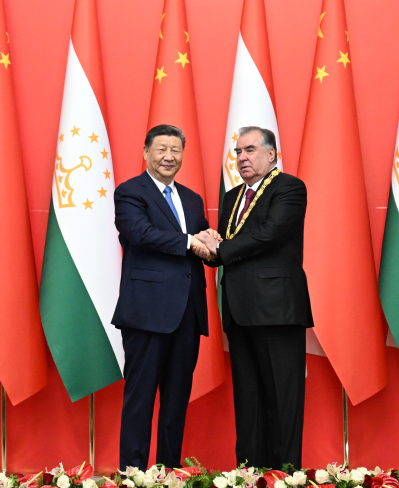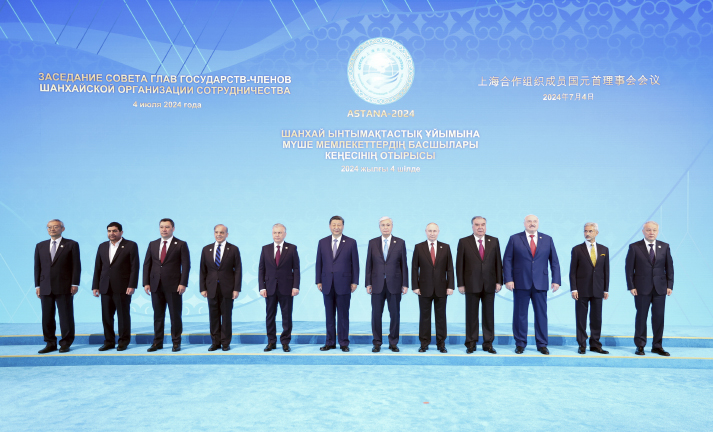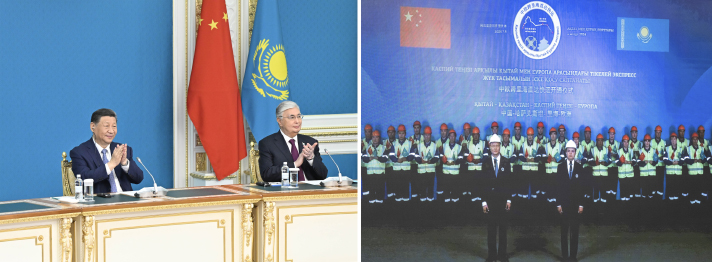| World |
| Insights from the Silk Road | |
|
|
 Chinese President Xi Jinping awards Emomali Rahmon, President of Tajikistan, the Friendship Medal of the People's Republic of China, in Dushanbe, Tajikistan, on July 5 (XINHUA)
Back in 2013, Chinese President Xi Jinping made his very first Central Asia visit as China's head of state and put forward the initiative of jointly building the Silk Road Economic Belt in Astana, Kazakhstan. The initiative, together with the 21st-Century Maritime Silk Road he proposed the following month in Indonesia, constitutes the Belt and Road Initiative (BRI), which aims to boost connectivity along and beyond the ancient Silk Road routes. Since then, the region has been a frequent destination for Xi as China strengthens its bilateral and multilateral ties there. He was there once again from July 2 to 6. He attended the 24th Meeting of the Council of Heads of State of the Shanghai Cooperation Organization (SCO) in Astana, and also paid state visits to Kazakhstan and Tajikistan. Xi's trip is significant for guiding the direction of the SCO's development, deepening China's good-neighborly relations with Central Asian countries and promoting the substantial advancement of building a community with a shared future among neighboring countries, Chinese Foreign Minister Wang Yi said on July 6, adding that during Xi's attendance at the SCO meeting, he also held intensive bilateral meetings with Russian President Vladimir Putin and other participating leaders. The Shanghai Spirit One of the highlights at this year's SCO gathering was Belarus' official admission as the 10th member state of the inter-governmental organization. Belarus' accession to the SCO is a wonderful gift to the Belarusian nation, Belarusian President Alexander Lukashenko said, adding, "Belarus is very proud to become a full member of the SCO. We will strengthen the Shanghai Spirit of the organization based on the principles of mutual respect, equality and solidarity." As a new type of regional cooperation mechanism established after the Cold War, the SCO has expanded its geographical coverage with the increase of its member states to 10, Sun Zhuangzhi, Director of the Institute of Russian, Eastern European and Central Asian Studies, Chinese Academy of Social Sciences, said. Since its inception in Shanghai in 2001, the SCO has expanded from a regional organization with six members into a trans-regional organization with 10 full members, two observer countries and 14 dialogue partners. "It has become the most extensive and populous regional organization in the world, and its influence and appeal have been continuously enhanced, with more countries agreeing with the concepts and principles advocated by the SCO and hoping to participate in its cooperation process," Sun added. As modernization is the shared goal of all countries in the SCO, Xi proposed 2025 be designated as the SCO Year of Sustainable Development to help the members focus on fostering new forces for growth. The summit issued the Astana Declaration, an SCO initiative on world unity for justice, harmony and development, and a statement on the principles of good neighborliness, trust and partnership, as well as 26 outcome documents covering a wide range of fields such as economy, finance and security. "The declaration, in particular, emphasized that against the backdrop of the complex and ever-changing international situation, the SCO should strengthen its internal unity and its joint efforts to maintain world peace and stability," Ding Xiaoxing, Director of the Institute of Eurasian Studies, at the China Institutes of Contemporary International Relations, told Beijing Review. China will assume the rotating presidency of the SCO following Kazakhstan and it has made all-round preparations, Sun said. "By integrating multilateral, mini-multilateral and bilateral cooperative approaches, it will further enable the joint participation of governments, enterprises and social organizations, thus forming a more positive operating mechanism and cooperative atmosphere, he added.  Chinese President Xi Jinping poses for a group photo with leaders attending the 24th Meeting of the Council of Heads of State of the Shanghai Cooperation Organization at the Independence Palace in Astana, Kazakhstan, on July 4 (XINHUA)
Enduring friendship In 2021, the World Economic Forum estimated that 90 percent of the world's traded goods are shipped by ocean. However, land-locked countries, including Kazakhstan, do not have the access to this cheaper form of trade transport. Through its BRI participation in recent years, Kazakhstan, the largest land-locked country in the world, has transcended this geographical limitation through extensive development of its transportation network. On July 3, Xi, on his fifth state visit to the country, attended the opening ceremony of the Trans-Caspian International Transportation Route (TITR) via video link with Kazakh President Kassym-Jomart Tokayev. The Caspian Sea is the world's largest inland body of water, surrounded by Kazakhstan, Russia, Turkmenistan, Iran and Azerbaijan. Over the past few years, Kazakhstan has been modernizing its ports, crucial components of the TITR, which begins at China's port of Lianyungang in Jiangsu Province and runs through Kazakhstan, the Caspian Sea, Azerbaijan, Georgia and on to European countries. Gaidar Abdikerimov, Secretary General of the TITR International Association, said that the route has become a vital artery for transporting goods from Southeast Asia and China to Europe. The two sides also enhanced their "soft connectivity" through new cultural and educational projects. Apart from attending the opening ceremony of the Chinese Culture Center in Astana and the Kazakh Culture Center in Beijing, the two heads of state also unveiled the Kazakhstan Branch of Beijing Language and Culture University on the same day. These projects, poised to enhance both bilateral and regional connectivity, highlight the two countries' commitment to strengthening ties, and evoke the region's illustrious history as a crossroads of trade and culture, read a Xinhua News Agency report. The partnership between China and Kazakhstan is rooted in the ancient Silk Road that has stretched for thousands of years. It is built upon strong bonds of solid friendship and good neighborliness, Tokayev told Xinhua. In 2023 alone, a number of important agreements were reached, including the implementation of a mutual visa-free policy, the construction of a third railway checkpoint, the establishment of cultural centers, and the announcement of 2024 as the Kazakhstan Tourism Year in China, the Kazakh president said. During their talks, the two leaders reaffirmed their strong political will to promote the building of a China-Kazakhstan community with a shared future, and made new plans to usher in a new "golden 30 years" of bilateral relations. When jointly meeting the press with Tokayev, Xi said that the two sides agreed to continuously deepen cooperation in traditional areas such as economy, trade, investment, production capacity, interconnectivity and energy, and jointly foster new growth points in critical minerals, new energy, scientific and technological innovation, aerospace, the digital economy and other fields. China remains steadfast in its commitment to the China-Kazakhstan friendship, in its resolve to advance cooperation across the board, in its determination to continue mutual support on issues concerning each other's core interests, and in its confidence in both countries realizing their development goals, Wang said.  Chinese President Xi Jinping and Kassym-Jomart Tokayev, President of Kazakhstan, attend the opening ceremony of the Trans-Caspian International Transportation Route via video link at the presidential palace in Astana, Kazakhstan, on July 3 (XINHUA)
Upgraded ties In Dushanbe, Tajikistan's capital, two newly erected architectural complexes stand less than 1 km apart. On July 5, Xi and Tajik President Emomali Rahmon attended the inauguration of the two buildings—parliament and government buildings built by China. They have become new landmarks symbolizing the friendly cooperation between China and Tajikistan, according to Xi. "China is ready to work with Tajikistan to continue to uphold the principles of extensive consultation, joint contribution and shared benefits, carry out more cooperation projects in Tajikistan and make greater contribution to the economic and social development of Tajikistan," he added. The buildings are the most precious gift given to the people of Tajikistan by Xi on the occasion of the 10th anniversary of his first state visit to the country in 2014, and another testimony to the profound friendship between the two countries, Rahmon said, adding that they will surely be recorded in the annals of Tajikistan-China relations and be celebrated by people in Tajikistan for generations to come. "Head-of-state diplomacy has always played an important leading role in boosting the relationship between China and Central Asian countries," Ding said. Take the relationship between China and Tajikistan as an example: Xi has just made his third visit to Tajikistan, while Rahmon has visited China many times. To date, the two presidents have had 15 meetings in total. Their positive interactions have played a prominent strategic leading role in upgrading bilateral relations—during Xi's recent visit, the two countries announced the establishment of a comprehensive strategic cooperative partnership in the new era, and the joint building of a community with a shared future from a higher starting point. Tajikistan was among the first countries to participate in the BRI. A number of China-Tajikistan joint projects have been implemented, including a cement plant in Yavan, an agriculture technology demonstration center in Khatlon, and an agriculture and textile park in Dangara. They have helped upgrade Tajikistan's industrial technology and generated thousands of local jobs. The two countries have established a paradigm of equal cooperation between large and small nations. Tajikistan, a small country with an area of 140,000 square km and a population of 10 million, feels highly valued by China, Sun said. He added that bilateral collaboration has indeed yielded tangible results, with China long being Tajikistan's largest source of investment and its major trading partner, with two-way trade hitting a record high of nearly $4 billion last year. In Dushanbe, Xi also awarded Rahmon China's highest state honor for foreigners—the Friendship Medal of the People's Republic of China. It was the first time the award was presented outside of China. BR Copyedited by G.P. Wilson Comments to mamm@cicgamericas.com |
|
||||||||||||||||||||||||||||||
|